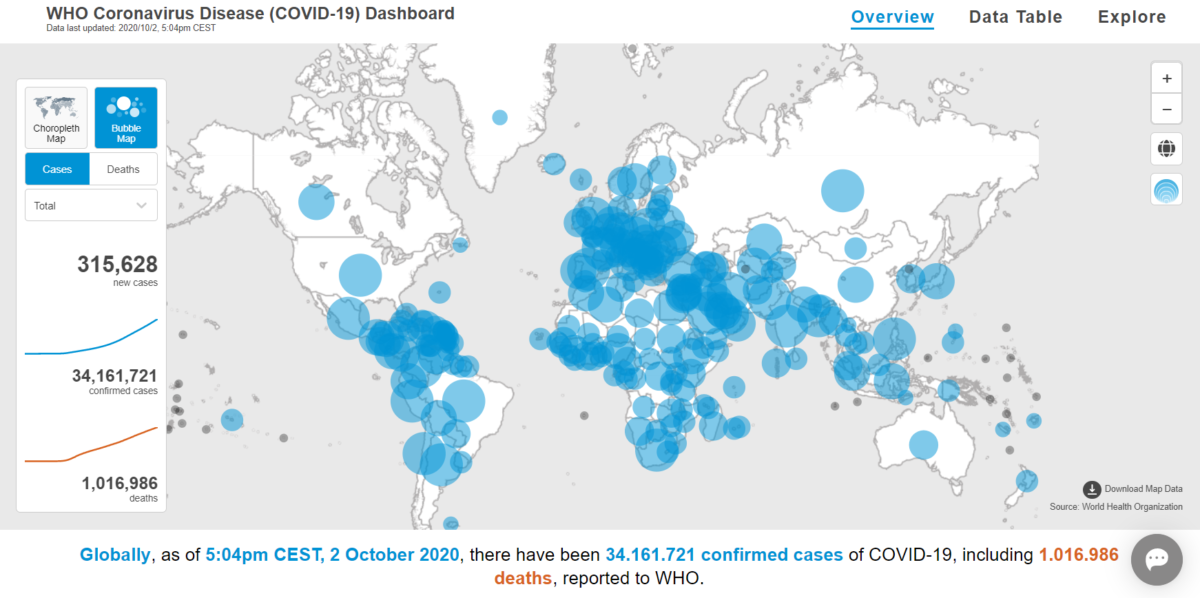Over the past decades all data technologies, including data acquisition, processing, storing and publishing, have become cheaper than ever (Hazel, 2020). As a consequence, unprecedented opportunities exist for producing insights from data. During COVID-19, these opportunities are exploited by using data for data-driven decision making in outbreak management.
To the reader it may seem as though it is not surprising that data is utilised for outbreak-related decision-making. However, only about a century ago this was unthinkable of. Per example, in 1918, the ‘Spanish flu’ broke out, a viral infection caused that infected approximately a third of the world’s population (Chowell, Viboud and Simonsen, 2018). During that time, data technology was not as advanced and the general public not as informed. As a result, the wider public had very limited knowledge of the outbreak that was occurring, what it was caused by, how many people were infected, and what one could do to avoid getting infected (Standford, n.d.).
When comparing the Spanish flu to the current COVID-19 outbreak, it is evident that the world looks a whole lot different right now. Newspapers are filled with the latest updates on the number of COVID-19 cases, hospitalisations and deaths, as well as the latest medical research and vaccination trial updates. Therefore, it is interesting to briefly touch upon three areas of COVID-19 where data plays a significant role.
1) Early warnings on the outbreak
Increased openness in data, combined with an enhanced understanding of viral outbreaks enabled the scientific world to alert on the COVID-19 outbreak shortly after the first cases appeared. According to some, the AI-based warning system Healthmap was actually the first to flag the COVID-19 outbreak, before ‘human’ research groups did (Heaven, 2020). Healthmap gave an alert based on findings of ‘unknown pneumonia’ when scanning social media, online news and government reports for any signs of infectious disease outbreaks (Brien and Larsen, 2020). After the alerts were given out, researchers confirmed that it indeed concerned an outbreak (Brien and Larsen, 2020). These findings highlight that data availability, and the ability to scan data, are crucial for early warnings on infectious disease outbreaks.
2) Leveraging data-driven tools to halt the pandemic
Secondly, data-driven tools show to be highly relevant for halting the COVID-19 pandemic. These tools are diverse and range from surveillance tools, to dashboards and contact-tracing apps (European Data Portal, 2020). The one tool that probably most readers have stumbled upon are dashboards, which are provided by many different organisations, such as the John Hopkins University and the WHO. These dashboards provide overviews of the current status of the pandemic and disease trends, based on which authorities can determine the way forward. The image below illustrates a dashboard as such.

Figure 1. COVID-19 dashboard by the John Hopkins University (John Hopkins University, 2020)
3) Allocation of resources
In the early days of COVID-19, another common topic in newspaper headlines was whether sufficient equipment, ranging from hospital beds and ventilators to Personal Protective Equipment and testing kits would be available to address the surge in demand (European Data Portal, 2020). Fortunately, models on equipment availability were rapidly built and databases with real-time updates on stock enabled efficient allocation of resources (American Hospital Association, 2020). In a situation where a person who may not get access to a ventilator may suffer horribly, the ability to efficiently allocate resources is crucial for public health.
The abovementioned examples only show a glimpse of the omnipresent usage of data for analysing COVID-19 and mitigating the outbreak. What other examples can you think of? Do you think the available data was used well, or could we have done better? And what do you think the next step in data usage for outbreaks is?
References:
American Hospital Association (2020). ‘A Compendium of Models that Predict the Spread of COVID-19’ [online] Retrieved from: https://www.aha.org/guidesreports/2020-04-09-compendium-models-predict-spread-covid-19 (Accessed 02 October 2020)
Brien, M. O., Larsen, C. (2020). ‘Can AI flag disease outbreaks faster than humans – not quite’ [online]. Retrieved from: https://apnews.com/article/100fbb228c958f98d4c755b133112582 (Accessed 02 October 2020)
Chowell, G., Viboud, C., Simonsen, L. (2018). ‘How historical disease detectives are solving mysteries of the 1918 flu’ [online]. Retrieved from: https://theconversation.com/how-historical-disease-detectives-are-solving-mysteries-of-the-1918-flu-91887 (Accessed 01 October 2020)
Hazel, T. (2020). ‘Data is Cheap, Information is Expensive’ [online]. Retrieved from: https://www.datanami.com/2020/03/13/data-is-cheap-information-is-expensive/ (Accessed 02 October 2020)
Heaven, W. D. (2020). ‘AI could help with the next pandemic—but not with this one’ [online]. Retrieved from: https://www.technologyreview.com/2020/03/12/905352/ai-could-help-with-the-next-pandemicbut-not-with-this-one/ (Accessed 02 October 2020)
John Hopkins University (2020). ‘COVID-19 Dashboard by the Center for Systems Science and Engineering (CSSE) at Johns Hopkins University (JHU)’ [online]. Retrieved from: https://coronavirus.jhu.edu/map.html (Accessed 02 October 2020)
Stanford (n.d.). ‘The public health response’ [online]. Retrieved from: https://virus.stanford.edu/uda/fluresponse.html (Accessed 01 October 2020)
The European Data Portal (2020). ‘The Power of Data in the Everlasting Battle: Humanity vs. Virus (1/2)’ [online]. Retrieved from: https://www.europeandataportal.eu/en/impact-studies/covid-19/power-data-everlasting-battle-humanity-vs-virus-12 (Accessed 01 October 2020)


